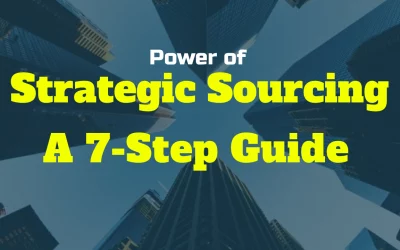Strategic and tactical sourcing are two different approaches to procurement that can significantly impact organizations. As a strategic sourcing analyst, I’m here to explain the differences between these two methods and how they work together for success.
First, it’s essential to understand what strategic sourcing is all about. In short, this approach focuses on understanding organizational needs to drive down costs and streamline processes over time. It considers more factors than price when making purchasing decisions, such as supplier performance or quality of products/services. Strategic sourcing requires an ongoing research and evaluation process to ensure purchases are made with long-term objectives in mind.
Tactical sourcing, on the other hand, is much more focused on finding immediate solutions at competitive prices without necessarily considering future goals. As a result, it’s often used when there isn’t enough time or resources available for a thorough strategic analysis. In those cases, quick decision-making based purely on cost savings is necessary. Though not as comprehensive as its counterpart, tactical sourcing can still be beneficial if done correctly—it can help organizations save money right away while also laying the groundwork for future strategy development.
What Is Strategic Sourcing?
Sourcing has come a long way since its humble beginnings. Today, it is an integral part of procurement departments around the world that helps to streamline their processes and boost business efficiency. Strategic sourcing is a strategic approach to purchasing goods and services which focuses on reducing costs while optimizing quality and value throughout the total cost of ownership. It involves creating a comprehensive sourcing strategy by leveraging data-driven insights from across functions such as finance, supply chain, operations, legal and human resources.
This process goes beyond traditional price negotiations – it looks at how to maximize savings through supplier consolidation, alternative suppliers, innovative payment terms and continuous performance monitoring for improved delivery times. Through this practical approach, companies can ensure they get the best possible return on investment for every purchase. From improving lead time to developing more effective relationships with suppliers, strategic sourcing provides all the benefits for organizations to stay competitive in today’s market.
What Is Tactical Sourcing?
Tactical sourcing is an integral part of the overall strategic sourcing process. It focuses on short-term objectives and vendor selection within a company’s supply chain management strategy for specific goods and services. The tactical approach to procurement allows organizations to make decisions quickly in order to manage their resources, but often without considering long-term savings or efficiencies that could be achieved through strategic supplier relationships.
Unlike strategic sourcing, which involves an extensive analysis of all potential suppliers and cost structures, tactical sourcing relies heavily on existing contracts. It leverages negotiation tactics such as volume discounts to achieve immediate value. Tactical sourcing requires accurate data collection and evaluation when selecting vendors to minimise future costs while still providing quality products or services. However, it does not involve complex analytics like those used in strategic sourcing processes.
The critical difference between tactical and strategic sourcing lies in the complexity of each approach. Strategic sourcing typically takes more time than tactical methods because it accounts for various variables that affect pricing over the longer term. In contrast, tactical systems are designed primarily for speed and convenience rather than ultimate savings. Ultimately, both strategies play essential roles in achieving business goals; however, understanding how they differ from one another will help you create a successful procurement strategy for your organization.
Differentiating Strategic And Tactical Sourcing
The divide between strategic and tactical sourcing is like night and day. Strategic sourcing works to optimize a company’s supply chain from start to finish, while tactical sourcing focuses on short-term goals resulting in immediate cost savings. To better understand the differences between these two approaches to procurement, here are five key points:
- Strategic sourcing requires extensive market research into the current industry landscape and long-term supplier relationships.
- Tactical sourcing utilizes existing processes and leverages immediate opportunities for cost savings without considering potential future risks or rewards.
- A strategic procurement process involves understanding customer needs, analyzing demand patterns, and creating value beyond price reductions.
- Due to tight deadlines and budget constraints, tactical procurement teams often prioritize speed over accuracy when making decisions.
- Strategic sourcing creates a sustainable competitive advantage by developing innovative solutions that align with corporate objectives. In contrast, tactical purchasing practices emphasize finding quick fixes within existing business models rather than exploring alternatives to traditional sourcing methods. With this information in mind, it’s clear why some companies choose one approach over the other depending upon their particular situation — both have advantages yet can also present unique challenges that must be addressed carefully. Moving forward, we’ll explore alternatives to traditional sourcing methods in greater detail.
Exploring Alternatives To Traditional Sourcing Methods
The difference between strategic and tactical sourcing lies in the approach taken to acquiring goods or services. Strategic sourcing involves a more long-term, holistic view of procurement that optimizes value for money by taking into account both internal and external factors such as cost, quality, time, resources, supplier relationships and risk management. By contrast, tactical sourcing is focused on short-term objectives such as price reduction and minimization of lead times.
Given the benefits of strategic sourcing over traditional approaches, many alternatives are available to companies today when procuring goods and services. From crowdsourcing platforms to digital marketplaces like Amazon Business or Alibaba Group’s B2B platform 1688.com, from strategic partnerships with suppliers to innovative pricing models, these options can provide significant advantages over traditional purchasing methods. Therefore, assessing their impact on business growth is essential if organizations want to stay competitive in an increasingly globalized economic landscape.
Assessing The Impact Of Strategic Sourcing On Business Growth
Strategic sourcing involves a systematic approach to purchasing decisions that allows organizations to attain the best possible value for their budget. It combines long-term contracts, competitive bidding processes, and various other tools to help reduce costs and increase efficiency. On the other hand, tactical sourcing is a more short-term approach that focuses on quickly obtaining needed goods or services with minimal effort.
The impact of strategic sourcing can be far-reaching in terms of business growth. By proactively managing the supply base, companies can maximise cost savings opportunities while improving contract negotiation skills. In addition, they can better manage supplier relationships which helps ensure continuity and consistency over time. This ultimately leads to improved operational performance and higher profits in the long run. Strategic sourcing also enables businesses to remain agile as market conditions change and new trends emerge.
This assessment highlights how strategic sourcing plays an important role in achieving organizational objectives. In addition, it provides a framework for making informed decisions regarding procurement activities, which have immediate and long-term implications for business growth. Analyzing cost savings potential through strategic sourcing initiatives to maximize investment returns will be essential.
Analyzing Cost Savings Potential Through Strategic Sourcing
“Time is money,” and this rings especially true in the world of strategic sourcing. As a procurement process, sourcing is used to obtain goods or services at lower costs while simultaneously improving processes. Whether companies are looking for cost-reduction measures or ways to improve their existing processes, strategic sourcing can help.
Unlike tactical sourcing, which is short-term in nature, strategic sourcing requires long-term planning and contract negotiation. Companies must use data such as market trends, supplier performance metrics, financials, etc., to make informed decisions that will ultimately result in cost savings potential. Additionally, differentiating between a fair price and versus optimal price may also be necessary when considering how much leverage exists within certain contracts. Ultimately, utilizing these key elements allows for successful cost-saving initiatives through the effective deployment of strategic sourcing strategies.
Analyzing cost savings potential through strategic sourcing involves leveraging data to inform decision-making regarding both pricing and vendors. With careful consideration of all available information – from current market conditions to contract terms – organizations can identify areas where they can reduce costs without sacrificing the quality of service or products received.
Examining Risk Mitigation Techniques In Strategic Sourcing
When analyzing strategic sourcing, risk mitigation should be a top priority. One of the key advantages of using this procurement method is that it allows for more visibility into lead times and extended terms. Data can also be used to leverage better vendor relationships to build mutually beneficial business partnerships. In addition, this allows organizations to reduce their exposure to risks associated with poor supplier selection or unreliable delivery schedules.
Companies must invest time and resources into data analysis to ensure success when mitigating risks through strategic sourcing. By leveraging data-driven insights about prospective vendors, organizations can make informed decisions that will help them achieve greater efficiency in their supply chain operations while minimizing potential losses due to unforeseen circumstances. This approach reduces costs and increases value by reducing the likelihood of delays or disruptions in production or distribution processes caused by unexpected events. With careful consideration and thorough examination of available information, businesses can gain a competitive edge by effectively managing their procurement strategies. As such, they can create secure agreements that result in improved outcomes overall.
Evaluating Risk-Reward Ratios For Tactical Vs Strategic Decisions
When deciding between tactical and strategic sourcing, evaluating the risk-reward ratio of each approach is essential. Strategic sourcing requires a proactive approach that involves researching long-term procurement needs to achieve business goals related to cost savings and purchasing power. By building relationships with suppliers, this method can lead to greater cost efficiency over time. Tactical sourcing focuses on short-term opportunities and takes a reactive approach based on current market conditions. This type of decision-making often yields quick results but carries more risks due to its shorter-term nature.
Both sourcing forms have advantages and disadvantages, which must be considered when evaluating the potential risks and rewards associated with each option. While both methods benefit companies looking to maximize value, strategic sourcing is more cost-effective in the long run by providing more excellent stability and predictability than tactical decisions made on an ad hoc basis. Companies need a comprehensive view of all available resources in order to make informed decisions about how best to meet their objectives – whether through strategic or tactical means.
Leveraging Technology For Maximum Efficiency In Strategic Sourcing
Ironically, in an age where technology continually strives to make our lives easier, procurement teams are still struggling with how to best leverage it for maximum efficiency in strategic and tactical sourcing. Yet the reality is that businesses must grow by utilizing a well-defined sourcing approach of using a strategic – rather than a reactive – mindset when procuring product or service data.
Here are four key ways that you can use technology to enhance your strategic sourcing:
- Automate manual processes such as supplier selection and evaluation
- Utilize analytics to gain insights into trends within the market.
- Improve visibility across the entire supply chain ecosystem.
- Streamline communication between internal stakeholders and suppliers.
By taking advantage of these options, you’ll be able to identify opportunities for automation and outsourced partnerships, ultimately allowing you to drive cost savings while increasing the overall quality of products or services acquired through strategic means.
Identifying Opportunities For Outsourced Partnerships
When looking for ways to maximize efficiency in strategic sourcing, it is important to consider the differences between strategic and tactical sourcing. Strategic sourcing is a procurement method that considers cost savings over time, while tactical sourcing focuses on finding the lowest price for immediate needs. In addition, strategic sourcing takes a more holistic view of an organization’s supply chain and looks at quality and value-added services. It also helps identify opportunities for improving processes or opening up new sources of materials or supplies.
Organizations use both methods to achieve their objectives; however, when considering outsourcing partnerships, there is often room for tactical approaches. Tactical sourcing can help acquire short-term solutions quickly and economically by immediately obtaining the lowest cost option. This may include bringing on temporary staffing partners who can provide additional resources during peak seasons or outsourcing to companies like Phycomex who specialize in specific areas related to your suppliers. In this case, leveraging third parties should be evaluated based on its ability to increase efficiency while reducing overall costs, and more importantly, what gap can they fill that you may not have internally.
Conclusion
In conclusion, strategic sourcing offers immense potential for businesses looking to maximize efficiency and profitability. With an effective strategy in place, organizations can leverage the power of technology to identify opportunities for automation and outsource to reliable partners. The risk-reward ratio of tactical vs strategic decisions is vital, as it can significantly impact business growth. By considering risk mitigation techniques, companies can make sound decisions that will enable them to succeed in today’s competitive market. My advice? Don’t be afraid to take risks; with proper planning and execution, you’ll reap the rewards of your efforts. So what are you waiting for? Take control of your success by investing in strategic sourcing!






0 Comments